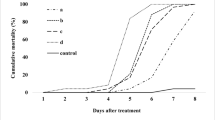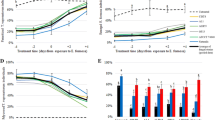Abstract
The potential for using the entomopathogenic fungus Lecanicillium muscarium to control the sweetpotato whitefly, Bemisia tabaci has been established in the laboratory by other studies. Laboratory studies however frequently overestimate the level of control achieved by biological control agents in the glasshouse. Before full-scale commercial or field development is considered, glasshouse trials are required to confirm laboratory results. Under both controlled laboratory and glasshouse conditions high mortality of second instar B. tabaci was recorded after application of L. muscarium. The potential of incorporating L. muscarium into integrated pest management strategies for the control of B. tabaci is discussed.
Similar content being viewed by others
References
D Gerling U Motro R Horowitz (1980) ArticleTitleDynamics of Bemisa tabaci (Gennadius) (Homoptera: Aleyrodidae) attacking cotton in the coastal plain of Israel Bull Entomol Res 70 213–219
M Nomikou A Janssen R Schraag MW Sabelis (2001) ArticleTitlePhytoseiid predators as potential biological control agents for Bemisia tabaci Exper Appl Acarol 25 271–291 Occurrence Handle10.1023/A:1017976725685
MD Alegbejo (2000) ArticleTitleWhitefly transmitted plant viruses in Nigeria J Sustain Agr 17 99–109 Occurrence Handle10.1300/J064v17n02_10
B Simón JL Cenis S Demichelis C Rapisarda P Caciagli D Bosco (2003) ArticleTitleSurvey of Bemisia tabaci (Hemiptera: Aleyrodidae) biotypes in Italy with the description of a new biotype (T) from Euphorbia characias Bull Ent Res 93 259–264 Occurrence Handle10.1079/BER2003233
M Ahmad MI Arif Z Ahmad I Denholm (2002) ArticleTitleCotton whitefly (Bemisia tabaci) resistance to organophosphate and pyrethroid insecticides in Pakistan Pest Manage Sci 58 203–208 Occurrence Handle10.1002/ps.440
M Cahill FJ Byrne I Denholm AL Devonshire KJ Gorman (1994) ArticleTitleInsecticide resistance in Bemisia tabaci Pest Sci 42 137–139
S Cheek O MacDonald (1994) ArticleTitleManagement of Bemisia tabaci Pest Sci 42 135–137
Cheek S, Head J, Malumphy C, Bemisia tabaci. Plant Pest Notice no. 17. Ministry of Agriculture, Fisheries and Food 1994; 4 pp
AGS Cuthbertson J Head KFA Walters SA Gregory (2003) ArticleTitleThe efficacy of the entomopathogenic nematode, Steinernema feltiae, against the immature stages of Bemisia tabaci J Invertebr Pathol 83 267–269 Occurrence Handle10.1016/S0022-2011(03)00084-3 Occurrence Handle12877837
AGS Cuthbertson J Head KFA Walters AWA Murray (2003) ArticleTitleThe integrated use of chemical insecticides and the entomopathogenic nematode, Steinernema feltiae, for the control of sweetpotato whitefly, Bemisia tabaci Nematology 5 713–720 Occurrence Handle10.1163/156854103322746887
AGS Cuthbertson KFA Walters P Northing (2005) ArticleTitleThe susceptibility of immature stages of Bemisia tabaci to the entomopathogenic fungus Lecanicillium muscarium on tomato and verbena foliage Mycopathologia 159 23–29 Occurrence Handle10.1007/s11046-004-3127-3 Occurrence Handle15750729
R Zare W Gams (2001) ArticleTitleA revision of Verticillium section Prostrata. IV. The genera Lecanicillium and Simplicillium gen. Nov Nova Hedwigia 73 1–50
G Schreiter TM Butt A Beckett S Vestergaard G Moritz (1994) ArticleTitleInvasion and development of Verticillium lecanii in the western flower thrips, Frankliniella occidentalis Mycol Res 98 1025–1034
Cuthbertson AGS, Walters KFA, Deppe C. Compatibility of the entomopathogenic fungus Lecanicillium muscarium and insecticides for eradication of sweetpotato whitefly, Bemisia tabaci. Mycopathologia 2005, in press
M Faria SP Wraight (2001) ArticleTitleBiological control of Bemisia tabaci with fungi Crop Prot 20 767–778 Occurrence Handle10.1016/S0261-2194(01)00110-7
EC Williams KFA Walters (2000) ArticleTitleFoliar application of the entomopathogenic nematode, Steinernema feltiae against leafminers on vegetables Biocontr Sci Technol 10 61–70 Occurrence Handle10.1080/09583150029396
MF MacGillivray GB Anderson (1957) ArticleTitleThree useful insect cages Can Entomol 89 43–46
JA Bethke TD Paine GS Nuessly (1991) ArticleTitleComparative biology, morphometrics and development of two populations of Bemisia tabaci (Homoptera: Aleyrodidae) on Cotton and Poinsettia Ann Entomol Soc Am 84 407–411
GD Butler TJ Henneberry TE Clayton (1983) ArticleTitleBemisia tabaci (Homoptera: Aleyrodidae): Development, Oviposition, and Longevity in relation to temperature Ann Entomol Soc Am 76 310–313
KH Wang JH Tsai (1996) ArticleTitleTemperature effect on development and reproduction of sliverleaf whitefly (Homoptera: Aleyrodidae) Ann Entomol Soc Am 89 375–384
AGS Cuthbertson CC Fleming AK Murchie (2003) ArticleTitleDetection of Rhopalosiphum insertum (apple-grass aphid) predation by the predatory mite Anystis baccarum using molecular gut analysis Agric For Entomol 5 219–225 Occurrence Handle10.1046/j.1461-9563.2003.00181.x
MJ Furlong Shi Zu-Hua Liu Shu-Sheng MP Zalucki (2004) ArticleTitleEvaluation of the impact of natural enemies on Plutella xylostella L. (Lepidoptera: Yponomeutidae) populations on commercial Brassica farms Agric For Entomol 6 311–322 Occurrence Handle10.1111/j.1461-9555.2004.00228.x
SG Candy (2003) ArticleTitlePredicting time to peak occurrence of insect life-stages using regression models calibrated from stage-frequency data and ancillary stage-mortality data Agric For Entomol 5 43–49 Occurrence Handle10.1046/j.1461-9563.2003.00161.x
EC Williams KFA Walters (1994) ArticleTitleNematode control of leafminers: Efficacy, temperature and timing Brighton Crop Protection Conference: Pest Dis 3 1079–1084
EC Williams OC MacDonald (1995) ArticleTitleCritical factors required by the nematode Steinernema feltiae for the control of the leafminers Liriomyza huidobrensis, Liriomyza bryoniae and Chromatomyia syngenesiae Ann Appl Biol 127 329–341
AGS Cuthbertson JP North KFA Walters (2005) ArticleTitleEffect of temperature and host plant leaf morphology on the efficacy of two entomopathogenic biocontrol agents of Thrips palmi (Thysanoptera:Thripidae) Bull Ent Res 95 321–327 Occurrence Handle10.1079/BER2005363
Author information
Authors and Affiliations
Corresponding author
Rights and permissions
About this article
Cite this article
Cuthbertson, A.G.S., Walters, K.F.A. Pathogenicity of the Entomopathogenic Fungus, Lecanicillium muscarium, against the Sweetpotato Whitefly Bemisia tabaci under Laboratory and Glasshouse Conditions. Mycopathologia 160, 315–319 (2005). https://doi.org/10.1007/s11046-005-0122-2
Received:
Accepted:
Issue Date:
DOI: https://doi.org/10.1007/s11046-005-0122-2




